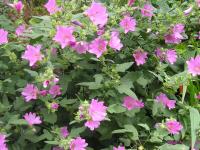Lavatera Pruning, Care and Growing Tips
 Lavatera shrubs are short lived, but produce a mass of flowers at their peak
Lavatera shrubs are short lived, but produce a mass of flowers at their peak Lavatera shrubs are often short-lived, but grow extremely quickly. A hard annual prune can extend their lives and optimise their fantastic floral displays.
One of the first jobs to do in the garden in early and mid spring (when it should be warm enough to spend extended periods of time working in the garden), is Lavatera pruning, ideally when the danger of hard frost has past
The genus Lavatera is in the family Malvacea. The common name most frequently used is ‘Mallow’. The genus contains approximately 25 species, consisting of annuals, biennials, herbaceous and evergreen perennials and deciduous, semi-evergreen and evergreen shrubs. Lavatera are found growing in the wild throughout the world including Russia, U.S.A., Australia and Europe. In their natural environment, they usually grow on poor, rocky soil, often in coastal regions. The conditions in the root zone therefore are usually free draining and you need to mimic this for the best results in your own garden with Lavatera. This preference for poor, freely draining soil make Lavatera ideal for a drought tolerant garden.
Popular with gardeners because of their large, showy, 5-petalled flowers produced for very long periods in summer Lavatera plants are easy to grow and are great value for money. A large Lavatera bush can often produce thousands of flowers from early summer to mid-autumn. The Lavetera flowers are also very attractive to bees and other insects.
Of the different cultivars available, Lavatera x clementii ‘Barnsley’ is popular in UK gardens. It reaches a maximum height and spread of 2 metres and flowers from June until September. The flowers are holly-hock like, whitein colour when they first open and have red centres. As the flowers mature they change in colour to a pale pink.
Another sought after cultivar is Lavatera x clementii ‘Rosea’. This cultivar has darker pink flowers, again produced in large numbers from June to September.
Despite being fully hardy (able to withstand temperatures down to –15C) or frost hardy (able to withstand temperatures down to –5C) Lavatera will always perform best in the warmest, sunniest parts of the garden. Such a site, combined with the previously mentioned good drainage and a hard annual prune can potentially produce more than two metres of growth in about 4 or 5 months and thousands of flowers.
Lavatera pruning is not hard, in fact, a Lavatera plant is a great choice for novice gardeners to begin their pruning training with because it is simple and easy to do and the spectacular results can be witnessed within a few months, This gives a sense of achievement and confidence begins to build.
The purpose of pruning a Lavatera shrub is to instigate the vigorous growth and the development of strong, healthy young shoots that will produce lots of flowers in the summer.
Left unpruned, stems from the previous year’s stems will become woody, brittle and will not flower as prolifically.
When to Prune Lavatera
Lavatera are best pruned in early to mid Spring.
How to Prune Lavatera
Here is a short 3 step guide to pruning Lavatera shrubs:
Tools Required: Secateurs, Loppers and a Pruning saw.
- Using a clean, sharp pair of secateurs cut down all the stems to within 1ft of the ground. For the thickest stems you will need a pair of loppers or even a pruning saw.
- If there are any weak or brittle stems that snap easily when you bend them then these should be removed right down to soil level because they are probably dead. Another way to check is to scrape a small section of bark away with the blade of your secateurs, if it is green under the bark the stem is alive, if it is brown it is dead.
- Pruning cuts you make on healthy stems should ideally be made just above where you see the stem slightly bulging or swelling. It is at this point that the new stem shoot is developing under the bark.
Lavatera shrubs live their short lives to the full, give them a bit of annual care and maintenance and you might enjoy them for longer than expected!
Filed under Shrubs.
